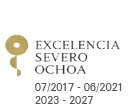Activity Detail
Seminar
Enlarging the Nanoworld: conductive 3D scaffolds for Neural and Cardiac Reconnection
Núria Alegret Ramón
 Electrically active tissues, such as the heart and neurons and nerves from the central nervous system, have little intrinsic repair ability. Injuries or degenerative diseases affecting these systems, e.g., spinal cord injury or myocardium diseases, are among the highest disease burdens worldwide. As result, the damaged systems lose functionality, leading to motion restrictions in the case of spinal cord injury or reduction of strength for contraction in myocardium diseases, and thus increasing the probability of premature or even sudden death. Permanent implantable 3D constructs able to restore the lost conductivity would be an ultimate solution for the functional recovery of damaged electroactive tissues. In that line, we have produced smart biohybrid hydrogels and porous scaffolds integrating carbon nanotubes (CNTs), one of the most promising materials to interface with electrically active tissues. The morphology, shape and porosity are critical parameters, and electrical conductivity are important assets when dealing cell regeneration and/or tissue recovery. Therefore, we have developed several methodologies to produce a large variety of CNT-integrating 3D scaffolds with different mechanical and electrical properties. Furthermore, 3D cellular organization was demonstrated to be able to induce cellular network outputs very similar to real in vivo tissue. We have proven our devices to be highly biocompatible, boosting and reinforcing neuronal and cardiac cell signals when compared to control or other CNT-free materials, and efficiently propagate the electrical signal in vitro. Finally, we have implanted the scaffolds onto mice hearts and sciatic nerves to prove their accommodation and biocompatibility in vivo, thus showing great potential to the treatment of both cardiomyopathies and nerve regeneration.
Electrically active tissues, such as the heart and neurons and nerves from the central nervous system, have little intrinsic repair ability. Injuries or degenerative diseases affecting these systems, e.g., spinal cord injury or myocardium diseases, are among the highest disease burdens worldwide. As result, the damaged systems lose functionality, leading to motion restrictions in the case of spinal cord injury or reduction of strength for contraction in myocardium diseases, and thus increasing the probability of premature or even sudden death. Permanent implantable 3D constructs able to restore the lost conductivity would be an ultimate solution for the functional recovery of damaged electroactive tissues. In that line, we have produced smart biohybrid hydrogels and porous scaffolds integrating carbon nanotubes (CNTs), one of the most promising materials to interface with electrically active tissues. The morphology, shape and porosity are critical parameters, and electrical conductivity are important assets when dealing cell regeneration and/or tissue recovery. Therefore, we have developed several methodologies to produce a large variety of CNT-integrating 3D scaffolds with different mechanical and electrical properties. Furthermore, 3D cellular organization was demonstrated to be able to induce cellular network outputs very similar to real in vivo tissue. We have proven our devices to be highly biocompatible, boosting and reinforcing neuronal and cardiac cell signals when compared to control or other CNT-free materials, and efficiently propagate the electrical signal in vitro. Finally, we have implanted the scaffolds onto mice hearts and sciatic nerves to prove their accommodation and biocompatibility in vivo, thus showing great potential to the treatment of both cardiomyopathies and nerve regeneration.





